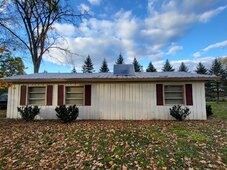I am installing my own DIY system which consists of 6x 100-watt panels wired in series groups of 2 each to create a 24v system. These will go on my garage roof, into my garage, and into a charge controller (which then feeds a small battery bank of 2 batteries in series, about 2500w total storage and that feeds an inverter). There is no grid tie, so this is completely isolated from mains. Basically all I'm using this for is to power a heat pump and for aux power druing a mains outage.
My question is on NEC rapid shutdown requirements. My state has adopted the 2017 rules which state that 30 seconds after rapid shutdown is engaged, voltage inside the array as well as within 3 feet of the building entry point must not exceed 80 volts and voltage outside the array as well as outside of 3 feet of the building entry point must not exceed 30 volts.
So ultimately I have 2 questions. First, because the open voltage rating of an individual panel is just over 24v, I don't believe any 2 points within the array boundary would ever exceed 49v (maybe somewhat higher in cold temps, but never over 80v even when applying the temperature factor multiplier), regardless of whether or not the array is fully energized by the sun or not. As such, would that effectively exempt the array from the RSD requirement as it pertains to inside the array? I can't think of any 2 connection points where this would even theoretically be exceeded.
Second, I obviously would exceed 30v outside the array when the array is energized. But if I install the outer-most solar panel within the array at the edge of the garage roof, can I combine that 1 foot allowance vertically down from there with the 3 feet allowance for building penetration location and simply mount a disconnect switch 4 feet down? By my interpretation of the rules, a switch in such a location would make it such that there is no point between the array and the switch (so long as both the switch and the building entry point are both within 4 feet of the panel edge) that would be subject to the 30v rule, and obviously everything on the other side of the switch, once in the off position, would be de-energized (at least up to the charge controller). Am I interpreting this all correctly?
And a smaller point - which actually applies? 1 meter, or 3 feet? Because 1 meter is 39.3 inches, thereby arguably giving me an additional 3.3 inches of allowance.
My question is on NEC rapid shutdown requirements. My state has adopted the 2017 rules which state that 30 seconds after rapid shutdown is engaged, voltage inside the array as well as within 3 feet of the building entry point must not exceed 80 volts and voltage outside the array as well as outside of 3 feet of the building entry point must not exceed 30 volts.
690.12(B)(1) Outside the Array Boundary. Controlled conductors located outside the boundary or more than 1 m (3 ft) from the point of entry inside a building shall be limited to not more than 30 volts within 30 seconds of rapid shutdown initiation. Voltage shall be measured between any two conductors and between any conductor and ground.
...
690.12(B)(2)(2) Controlled conductors located inside the boundary or not more than 1 m (3 ft) from the point of penetration of the surface of the building shall be limited to not more than 80 volts within 30 seconds of rapid shutdown initiation. Voltage shall be measured between any two conductors and between any conductor and ground.
So ultimately I have 2 questions. First, because the open voltage rating of an individual panel is just over 24v, I don't believe any 2 points within the array boundary would ever exceed 49v (maybe somewhat higher in cold temps, but never over 80v even when applying the temperature factor multiplier), regardless of whether or not the array is fully energized by the sun or not. As such, would that effectively exempt the array from the RSD requirement as it pertains to inside the array? I can't think of any 2 connection points where this would even theoretically be exceeded.
Second, I obviously would exceed 30v outside the array when the array is energized. But if I install the outer-most solar panel within the array at the edge of the garage roof, can I combine that 1 foot allowance vertically down from there with the 3 feet allowance for building penetration location and simply mount a disconnect switch 4 feet down? By my interpretation of the rules, a switch in such a location would make it such that there is no point between the array and the switch (so long as both the switch and the building entry point are both within 4 feet of the panel edge) that would be subject to the 30v rule, and obviously everything on the other side of the switch, once in the off position, would be de-energized (at least up to the charge controller). Am I interpreting this all correctly?
And a smaller point - which actually applies? 1 meter, or 3 feet? Because 1 meter is 39.3 inches, thereby arguably giving me an additional 3.3 inches of allowance.






